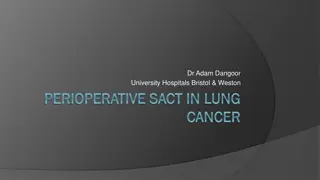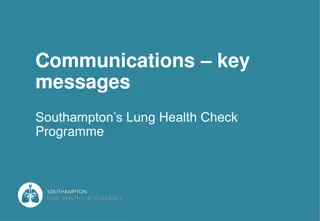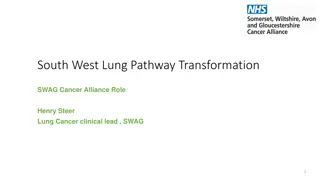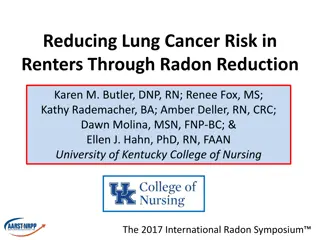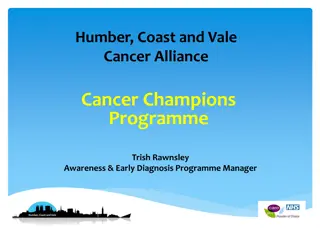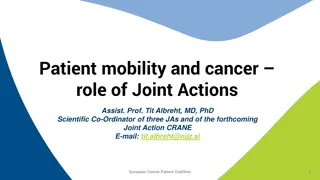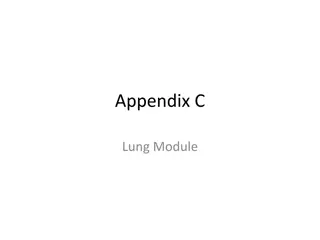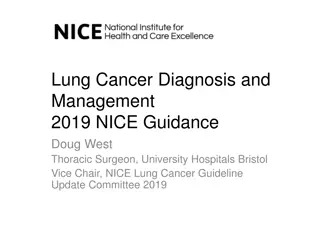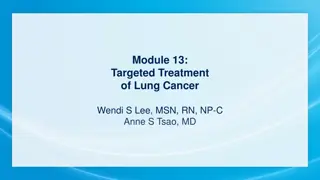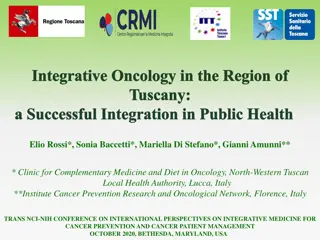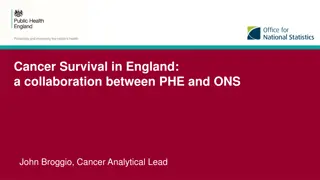Lung Cancer Questions and Answers
This set of questions covers various aspects of lung cancer, including statistics, TNM staging, non-small cell lung cancers, and small cell lung cancers. Each question presents multiple choices, testing the reader's knowledge on different topics related to lung cancer.
Download Presentation

Please find below an Image/Link to download the presentation.
The content on the website is provided AS IS for your information and personal use only. It may not be sold, licensed, or shared on other websites without obtaining consent from the author. Download presentation by click this link. If you encounter any issues during the download, it is possible that the publisher has removed the file from their server.
E N D
Presentation Transcript
Lung Cancer SCE questions Matt Dickson 16/01/2018
Question 1 In relation to lung cancer statistics, which of the following is true? a) 60% of lung cancer is smoking related b) 25% of patients are diagnosed at stage I or II c) Late stage at diagnosis of lung cancer is associated with female sex in England d) NSCLC account for 60% off all lung cancers e) Lung cancer is the second most common cancer in the UK
Question 2 In relation to the 8thedition of TNM staging, which of the following is false? a) Primary tumour of greater than 2cm but less than 3cm in diameter is represented as T1c b) N1 indicates ipsilateral peribronchial/hilar lymph nodes and intrapulmonary nodes c) T4 tumours are those >6cm or of any size that invade other organs d) M1c indicates multiple extrathoracic metastasis in a single or multiple organs e) Stage IVA corresponds to any T, any N and M1a/b
Question 3 In relation to non small cell lung cancers, which of the following is false? a) Radical radiotherapy can be offered for patients with stage I, II or III NSCLC who have good performance status (WHO 0, 1) and whose disease can be encompassed in a radiotherapy treatment volume without undue risk of normal tissue damage b) Offer postoperative chemotherapy to patients with good performance status (WHO 0 or 1) and T1 3 N1 2 M0 NSCLC c) For patients with NSCLC who are suitable for surgery, offer neo- adjuvant chemotherapy d) All patients should undergo pulmonary function tests (including lung volumes and transfer factor) before having radical radiotherapy for NSCLC e) Offer patients with predicted postoperative FEV1or TLCO below the recommended limit of 30% the option of undergoing surgery if they accept the risks of dyspnoea and associated complications
Question 4 In relation to small cell lung cancers, which of the following is false? a) Patients should have an assessment by a thoracic oncologist within 2 weeks of deciding to recommend treatment b) Consider surgery in patients with early-stage SCLC (T1 2a, N0, M0) c) Prophylactic cranial irradiation is offered in those of WHO PS2 or less, in whom disease has not progressed following first-line treatment d) Cisplatin based chemotherapy should be offered first-line in those with limited stage disease e) Platinum based combination chemotherapy should be offered first-line in those with extensive disease
Question 5 Which statement is true regarding Pembrolizumab? a) It is a humanised monoclonal antibody that acts on the EGFR protein b)It is humanised monoclonal antibody that acts on the PD-L1 protein c) Influenza vaccination is advised during treatment d) KEYNOTE-024 trial demonstrated pembrolizumab was associated with shorter progression-free and overall survival compared to platinum-based combination chemotherapy e) Pembrolizumab can reduce the risk of rejection in organ transplant patients
Question 6 In relation to locally advanced/metastatic NSCLC, which statement is true? a) Afatinib, gefitinib or erlotinib can be offered as first line treatments if EGFR mutation positive b) Crizotinib targets the PD-L1 receptor c) Osimertinib is first line treatment if EGFR T790M mutation-positive NSCLC d) Nintedanib is not a recommended second-line option in combination with docetaxel e) All the above drugs are cheap
Question 7 In terms of lung cancer prognosis, which of the following is true? a) Net survival of men at 1 year is 50% b) 5-10 year survival rates have improved by 15% since the 1970s c) 5 year survival rates in men in the UK are above the European average of 12% d) Survival rates are at their highest in the over-50s e) 5% of patients survive 10 years or longer
Question 8 In relation to mutations in NSCLC, which of the following is false? a) EGFR is more commonly seen in never smokers, women and/or Asian ethinicity b) ALK mutation is found in 5% of NSCLC c) EGFR mutation is seen in 15% of NSCLC d) PD-L1 mutation is found in a third of NSCLC e) Any proportionate amount of tumour expression with PD-L1 can be treated first line with targeted immunotherapy as per NICE guidance





